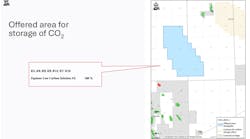Åsgard, Sleipner expansion planned
Statoil is experiencing mixed fortunes with its latest project spread. Plans for the Mikkel and Sigyn gas-condensate subsea developments have been submitted to the Norwegian authorities. Sigyn comprises two deposits, which would be tied back to the Sleipner East platform in the North Sea via a subsea template. The scheme has an estimated price tag of US$218 million.
Mikkel, costing US$43.6 million more, would be exploited through four producer wells and two subsea templates, with production exported to the Åsgard B platform in the Norwegian Sea. Statoil's partners on Sleipner West have also approved a new US$109 million compression project there to counteract falling reservoir pressure. Kværner has been contracted for modifications on the Sleipner T platform.
Another major upcoming development, the HP/HT Kristin in the Norwegian Sea, was recently selected by the authorities to supply gas contracted to continental European users from 2005 onwards. However, planning suffered a setback following disappointing results on an appraisal well on Erlend, one of a cluster of discoveries lined up for development through a production semi located on Kristin. The well, drilled by the Transocean Arctic, did not prove up extra reserves, as hoped. The proposed Snohvit LNG gas scheme in the Barents Sea may also be compromised, following reported disagreements between Statoil and the government over processing tariffs. Decisions on the project's future were due to be taken last month.
HP/HT production risk resolved
Shell UK Expro has resumed operations on its HP/HT (high pressure/high temperature) Shearwater Field following a seven-month shutdown of the platform. This followed an abnormal pressure surge in one of the field's wells, which was not in production at the time. Shell claims the situation did not pose a threat to the platform, but the work force was reduced to a minimum while investigations were conducted. In response, Shell installed new control systems to deal with any incidents, however unlikely, that would arise in the future.
The other current HP/HT gas-condensate project in the Central North Sea is TotalFinaElf's Elgin/Franklin, which came onstream late March. Two years ago, former operator Elf discovered a deeper-lying reservoir, named Glenelg, 11 km west of Elgin. TFE has since concluded that HP/HT techniques are not sufficiently advanced to attempt a subsea development, and is instead considering placing a wellhead platform on the field, which would be tied back to Elgin.
Timing depends on the availability of spare capacity on Elgin's TPG 500 production jackup. Glenelg's reserves are estimated at 70-100 million BOE, but further appraisal drilling is planned next year. TFE may also drill another prospect between Glenelg and Franklin.
German exploration in prospect
Germany's sector may experience a resurgence following a licensing deal involving Denerco and Intrepid Energy. Both have acquired 50% shares in license B20 008/64 in the Schill Grund High Basin, previously held by PGS and TGS for seismic investigation purposes. The transaction is thought to include seismic data acquired on the license since 1997, but not earlier datasets. The license area covers 5,775 sq km across four German quadrants.
According to analysts Wood Mackenzie, four wells were drilled there in the past, but all were dry holes. Denerco participated in numerous recent discoveries in the Danish sector, but so far was denied the chance to operate in its own backyard.
Swift development for Stine
In the Danish sector, Statoil's fastest-ever exploration well yielded a small find named Stine, 7 km east of the producing Siri Field. The jackup Noble George Sauvageau completed the operation in 10 days, including coring and logging. Oil was encountered in Paleocene sandstone. The rig has since moved to the Siri platform to drill a 7,200-meter horizontal production well into Stine, which should be brought onstream in September. The added production will partly reduce the 20,000 b/d spare capacity available on the platform. This gap might have closed further, had Statoil not aborted the planned Siri East development earlier this year, citing excessive rig rates.
Platform study monitoring motions
A group of North Sea operators commissioned a US$170,500 project to investigate use of sway monitoring techniques on 13 platforms. According to UK-based risk management consultant EQE International - performing the study with Fugro - every steel platform sways and twists under wave action with a unique set of frequencies. Nascent fatigue cracks alter structural stiffness, causing changes in the platform's motions. Operators could detect these changes quickly, EQE claims, through continuous motion monitoring. In turn, that would speed up repair action, minimizing the risk of damage to the installation.
EQE also will look at ways of adapting the technique for older platforms, which tend to be more intricate designs with greater numbers of structural members. "The so-called structural redundancy of older platforms means that failure of an individual structural member may have minimal impact on sway frequency and could be impossible to detect," says EQE's Simon Thurlbeck. But this could also mean that failure of a single member is less critical.
Wind power gaining momentum
Belgium lacks E&P appeal, but its offshore may soon house an installation of a different sort. Fina Eolia has applied to the country's Electricity and Gas Regulating Commission to install 40 wind turbines in two perpendicular lines, 8-17 km from the shore. These would be connected to the Belgian power grid through a subsea cable that would landfall near Zeebruge. It would be installed and commissioned in two 50 MW phases between 2003-2004, following a one-year authorization process which would include environmental and tourism impact studies.
Another wind power scheme is planned in northern Sweden, covering various offshore and onshore locations. This would be jointly managed by London-based wind energy company Windforce and Sweden's NordanVind Vindkraft. A recent Swedish government report called for the installation of 3-4,000 MW extra generating capacity within the next 10-15 years.




